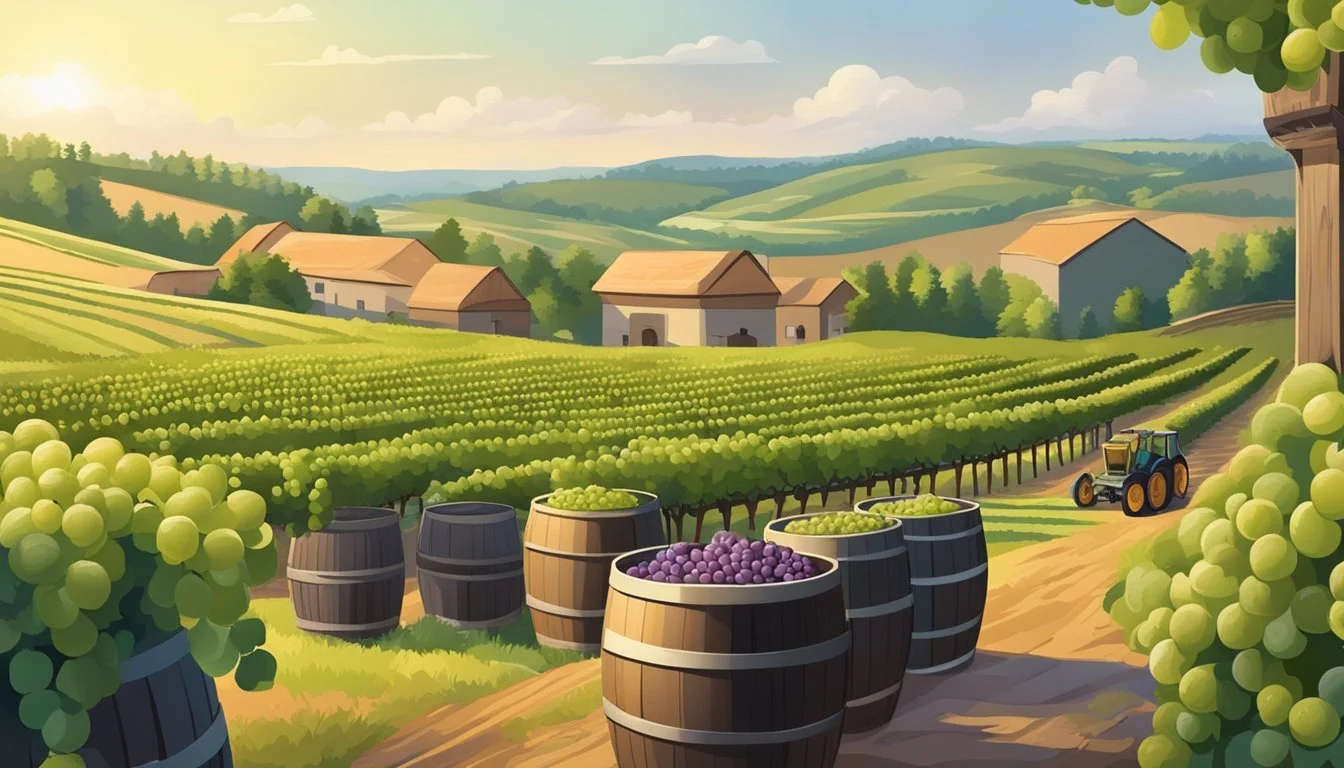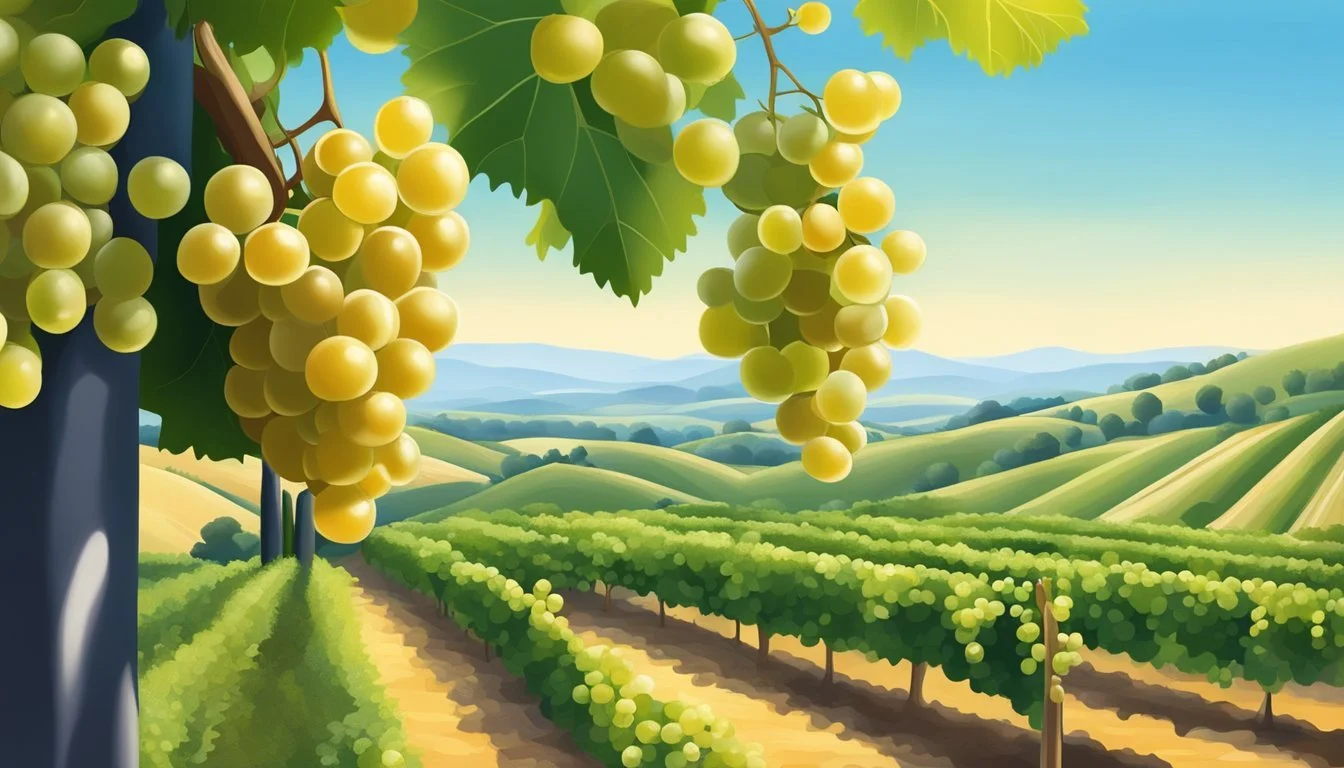How to Tell If Champagne Grapes Are Ripe
Identifying Peak Sweetness and Harvest Time
Determining when champagne grapes are ripe is a subtle art that stands as a critical step in the production of one of the world's most celebrated beverages. Champagne grapes typically have a limited harvest season, which in regions like California, potentially ranges from mid-July through September. The exact timing of the harvest can fluctuate based on factors such as geography, climate, and the variety of grape. A ripe champagne grape will exhibit certain physical characteristics that are discernible to the eye and touch, such as a specific coloration and firmness. Balancing sugar content, acidity, and flavor profile is the key to predicting the perfect harvest time, which is essential for the quality of the final product.
The stages of ripeness in champagne grapes are meticulously monitored, since they directly affect the complexity, taste, and aroma of the champagne. Grapes that are underripe can lead to overly acidic wine, while overripe grapes can result in a flatter, less vibrant champagne. Not only do the grapes need to be in perfect condition, but the timing of the harvest must align with the desired style of champagne, from the bone-dry 'Brut Nature' to the sweet and sumptuous 'Doux'. The knowledge of the land, the vine, and the climate all intertwine to guide winemakers in their quest to produce the optimal batch of champagne grapes for their sparkling wines.
Key Takeaways
The harvesting of champagne grapes is a fine-tuned process influenced by climate, region, and grape variety.
Ripeness is assessed through a balance of sugar, acidity, and flavor, which affects the champagne's taste profile.
Correctly timed harvest is critical to align with the desired champagne style, ensuring the right balance for each bottle.
Understanding Champagne Grapes
In the Champagne region, grape ripeness is crucial for producing the region's renowned sparkling wine. Vineyard managers monitor the grapes meticulously to ensure the optimum balance of sugar, acidity, and flavor profiles necessary for premium Champagne.
Varieties and Characteristics
Champagne is predominantly made from three grape varieties:
Chardonnay: A white grape known for its contributions to acidity, floral and citrus notes, and elegance in the wine.
Pinot Noir: A black grape that provides structure, body, and a breadth of red and dark fruit flavors.
Pinot Meunier: Also a black grape, it adds freshness, fruitiness, and a certain roundness to the blend.
These three varieties account for 99% of plantings in the area and are chosen for their adaptability to the region's climate and their ability to express its terroir. There are rarer varieties, including Pinot Blanc, Pinot Gris, Petit Meslier, and Arbane, each imparting unique characteristics to the wine but planted in much smaller quantities.
Pinot Blanc offers gentle fruitiness, while Pinot Gris introduces richness and body.
Petit Meslier is valued for its acidity and floral aromas.
Arbane is the rarest, with high acidity and a complex flavor profile but low yields.
Growth and Harvesting Cycles
The growth cycle for Champagne grapes begins with bud break in spring and continues through flowering and fruit set until the harvest in early autumn, typically around September. It's a delicate process where the vines are at the mercy of the region's variable climate, with frost being a particular concern.
Vintage expresses the quality of a particular year's harvest and plays a crucial role in Champagne production.
Yields are affected by numerous factors, including weather conditions and vine vigor, with careful management required to align quantity with quality.
Harvesting the grapes in Champagne is often done by hand to preserve the integrity of the fruit and the vineyard. The exact timing of the harvest is critical and based on the sugar and acid levels in the grapes, which must be at an optimal balance to create a wine that is both refreshing and capable of aging.
Variety: Chardonnay
Characteristics: High acidity, floral notes
Harvesting Time: Early September
Variety: Pinot Noir
Characteristics: Structure, red fruit flavors
Harvesting Time: Mid September
Variety: Pinot Meunier
Characteristics: Fruitiness, freshness
Harvesting Time: Early to mid September
Variety: Pinot Blanc
Characteristics: Gentle fruitfulness
Harvesting Time: Depends on vintage
Variety: Pinot Gris
Characteristics: Richness, body
Harvesting Time: Depends on vintage
Variety: Petit Meslier
Characteristics: High acidity, floral aromas
Harvesting Time: Depends on vintage
Variety: Arbane
Characteristics: Complex flavor, very high acidity
Harvesting Time: Late harvest
Grape ripeness is evaluated through regular testing as the harvest approaches, ensuring that when the grapes arrive at the pressing house, they are in their prime condition for creating the distinguished sparkling wine the region is celebrated for.
Assessing Ripeness
When determining if Champagne grapes are ripe, one must evaluate several critical aspects such as color and texture, sugar and acidity levels, as well as the flavor profile. These characteristics provide a comprehensive view of the grape's readiness for harvest.
Color and Texture
Champagne grapes, typically from the Chardonnay, Pinot Noir, and Pinot Meunier varieties, exhibit specific color changes as they ripen. Chardonnay grapes transition to a golden hue while Pinot Noir and Pinot Meunier grapes develop a deeper blue-black color. The texture of the grape berries also changes; ripe grapes will have firm skins with a slight give and the berry size may slightly increase. The flesh should easily separate from the skins, which should also exhibit increased chewiness.
Color changes: Golden for Chardonnay; blue-black for Pinot Noir and Pinot Meunier
Texture changes: Firm skins with a slight give, easy separation of flesh from skin
Sugar and Acid Levels
The sweetness of a grape, indicative of its sugar content, is a primary factor in assessing ripeness. Sugar levels are typically measured in degrees Brix, with Champagne grapes reaching an optimal range for harvest. Acidity, on the other hand, provides a balance to the sweetness and contributes to the wine's freshness. Acid levels decrease as the grapes ripen, but a certain level of acidity is crucial to maintain the wine's structure. These components are critical to the eventual champagne's balance of alcohol, sweetness, and acidity.
Sugar levels: Optimal Brix range for Champagne grapes
Acid levels: Maintain balance with sugar for wine structure
Flavor Profile
The flavor profile of ripe Champagne grapes is complex, encompassing a wide array of fruit flavors and aromas. A ripe Chardonnay grape may exude flavors of lemon and apple with hints of honey, indicative of its maturity and sugar accumulation. The grapes should have a pronounced fruitiness with no green or herbaceous characteristics, indicating that physiological ripeness has been achieved.
Fruit flavors: Lemon, apple, honey notes in Chardonnay
Aromas: Pronounced fruitiness without green notes
Champagne Production Process
The Champagne production process is defined by its unique and meticulous methodology, adhering to strict regional regulations that foster the iconic effervescence and depth of Champagne.
Winemaking Techniques
The initial stage of crafting Champagne involves developing a base wine. This process starts with the careful selection and harvesting of grapes, which are then gently pressed to extract the juice. The grape varieties permitted are mainly Pinot Noir, Chardonnay, and Pinot Meunier, the selection of which contributes to the complex profile of the final product. Winemakers blend wines from various vintages or vineyards in a process known as assemblage, crafting a consistent house style and balancing the flavor profile.
Secondary Fermentation
To generate the signature bubbles in Champagne, the base wine undergoes a second fermentation. After blending, winemakers add a mixture called liqueur de tirage, a combination of sugar and yeast, to the base wine. Bottles are sealed tightly, and the yeast cells convert the added sugar into alcohol and carbon dioxide, which, as it cannot escape, dissolves into the wine creating effervescence. This step is intrinsic to the méthode champenoise, also known as the traditional method.
Aging and Lees Contact
Following secondary fermentation, Champagne bottles are stored horizontally in a cellar, initiating the aging process. During this time, which typically lasts several years, the Champagne develops its flavors through contact with the lees (dead yeast cells). The extended lees contact allows for a complexity and bread-like aroma to develop that is characteristic of quality sparkling wines.
Riddling and Disgorging
Once the desired aging duration is complete, the bottles undergo riddling (remuage), a process where the bottles are gradually turned and angled so that the lees collect near the bottle's neck for removal. Finally, in a process called disgorgement (dégorgement), the bottle neck is frozen and the lees are expelled, followed by topping the bottle with a mixture of wine and sugar known as dosage. The Champagne is then corked, fitted with a wire cage, and prepared for sale.
Styles of Champagne
Champagne styles vary by age, sugar content, and specific production processes, each creating a distinct tasting experience. From the rich complexity of a vintage year to the nuanced sweetness levels and the exclusivity of specialty cuvées, understanding these styles is pivotal.
Non-Vintage vs. Vintage
Non-Vintage (NV) Champagnes blend multiple years' harvests to achieve a consistent house style. They represent the majority of Champagne production and are known for their quality and balance. NV Champagnes must age for a minimum of 15 months.
Vintage Champagnes, meanwhile, are made from grapes harvested in a single year, released only when the producer feels the weather conditions have led to an exceptional crop. These require aging for at least 36 months, resulting in a more complex and age-worthy Champagne that reflects the characteristics of the specific year.
Sweetness Levels
The sweetness of Champagne is determined by the dosage, a step in the finishing process where a mixture of wine and sugar is added. The levels of sweetness, from driest to sweetest, are:
Extra Brut: 0-6 grams of sugar per liter (g/L)
Brut: less than 12 g/L
Extra Sec: 12-17 g/L
Sec: 17-32 g/L
Demi-Sec: 32-50 g/L
Doux: more than 50 g/L
This spectrum from Extra Brut to Doux allows consumers to choose a Champagne that suits their palate, with Brut being the most commonly consumed.
Specialty Champagnes
Specialty Champagnes include Blanc de Noirs, Blanc de Blancs, Rosé Champagne, and Prestige Cuvée.
Blanc de Noirs: Made exclusively from black grapes, typically Pinot Noir and/or Pinot Meunier.
Blanc de Blancs: Made solely from white grapes, usually Chardonnay, known for their delicacy and finesse.
Rosé Champagne: This style gains its color from the skin contact of black grapes or the addition of still red wine to the blend.
Prestige Cuvée: The highest quality of Champagne, often from the best grapes in a producer's vineyards and handle with additional care.
These categories allow for a range of experiences, from the full-bodied Blanc de Noirs to the light and elegant Blanc de Blancs, and from the fruity Rosé Champagne to the often luxuriously crafted Prestige Cuvée.
The Champagne Region and Its History
The Champagne region is renowned for its unique terroir and centuries-old winemaking tradition, which have together forged a reputation for producing the world-famous sparkling wine known as Champagne.
Geography and Climate
Situated approximately 90 miles east of Paris, the Champagne region encompasses the towns of Reims and Épernay and is divided into distinct areas including the Montagne de Reims, Côte des Blancs, and Vallée de la Marne. The geography of Champagne is characterized by chalky hillsides, which contribute to the distinctive minerality of its wines. The climate is predominantly cool, a defining factor that allows the grapes to ripen slowly and maintain necessary levels of acidity for Champagne production.
Historical Development
The history of Champagne and its winemaking dates back to the Roman times, but it was the Benedictine monk Dom Pérignon in the 17th century who is often credited with many of the innovations that led to the method of producing sparkling Champagne. Over the centuries, numerous Champagne houses such as Bollinger and Laurent-Perrier have been established, each contributing to the region's reputation by crafting distinct styles of Champagne.
These houses utilize grapes from over 319 villages in the region, with some designated as Grand Cru due to their superior quality. The traditions and strict regulations within the Champagne region ensure that only wines made from specific grape varieties — primarily Chardonnay, Pinot Noir, and Pinot Meunier — and through the traditional method of secondary fermentation can be labeled as Champagne.
Tasting and Food Pairings
Understanding the subtleties in Champagne's flavors and the art of pairing it with food elevates the tasting experience. The section below distills the essence of how one can discern ripe Champagne grapes through tasting notes and suggests ideal food complements to harmonize with the champagne's character.
Tasting Notes
Champagne offers a mosaic of flavors and aromas, indicative of its ripeness and quality. A ripe Champagne typically presents a fine mousse—the lively, delicate bubble sensation on the palate—alongside a bright acidity that lends structure to the wine. The flavors range from white and citrus fruit to more complex notes of brioche, toast, and nuts, which derive from the aging process. The presence of these flavors in harmony with a persistent, elegant stream of bubbles and a creamy finesse often indicates the grapes were picked at the pinnacle of ripeness.
White Fruits: Apple, pear, white peach
Citrus Fruits: Lemon, grapefruit
Aged Notes: Brioche, toast, almonds, hazelnuts
Selecting Food Complements
When selecting food pairings for Champagne, complementing the beverage's flavor profile is key. For Champagnes with high acidity and vibrant fruit notes, lean towards lighter fare like raw oysters (What wine goes well with oysters?) or a simple charcuterie (What wine goes well with charcuterie?). Champagnes with a toasty, nutty character from extended aging pair well with richer foods, such as duck or creamy cheeses, to match the wine's complexity.
With Vibrant Acidity:
Oysters
Fresh goat cheese
With Toasty Notes:
Roasted chicken (What wine goes well with roasted chicken?)
Mushroom risotto (What wine goes well with mushroom risotto?)
With Sweet Profiles:
Fruit desserts
Blue cheeses (What wine goes well with blue cheeses?)
Global Sparkling Wines
Sparkling wines across the globe offer a diverse palate of flavors, production methods, and grape varieties, creating a world beyond Champagne that is ripe for exploration.
Alternative Regions and Styles
Regions throughout Italy, California, and even areas less traditionally known for sparkling wines, such as Israel and South Africa, have established their presence in the sparkling wine market. Italian sparkling wines such as Prosecco and Asti are particularly renowned for their light-bodied and acidic notes, with Prosecco using the Charmat method rather than the traditional Champagne method, leading to a more affordable price point. In contrast, Cava from Spain and Sekt from Germany also provide unique styles, with many utilizing the traditional method but at a range typically less expensive than their French counterpart.
Italy: Known for Prosecco (Charmat method) and Asti.
California: Notable for producing sparkling wines using the traditional method.
Spain: Cava is a staple, often made with the traditional method.
Germany: Sekt brings its own style to the table, sometimes using the traditional method.
Comparing Champagne and Its Counterparts
When one compares Champagne to its global counterparts, certain nuances become apparent. The Champagne method or traditional method—a process involving a secondary fermentation in the bottle—originates from the Champagne region of France, a name legally protected and cannot be used outside of its geographic designation. This method lends itself to a complex flavor profile that is often emulated by regions like California in North America. These regions use local grape varieties to create both red wine and white wine versions sparkling wines that aim to achieve a depth similar to Champagne.
North America: Emphasizes the use of the traditional method.
Traditional method: Secondary bottle fermentation producing complex wines.
By examining the diverse methods and styles from these alternative regions, one appreciates the rich tapestry that global sparkling wines contribute to the world of viticulture.





